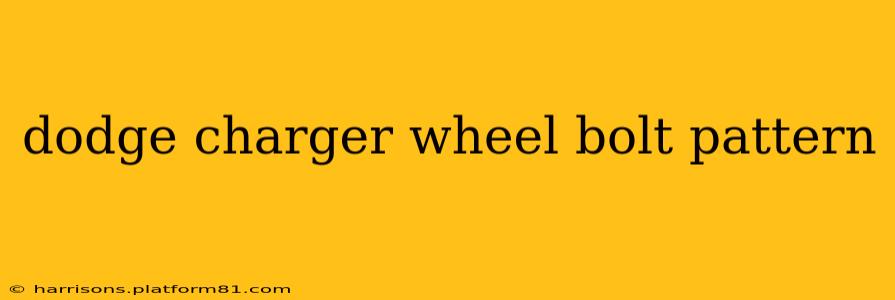The Dodge Charger, a muscle car icon, boasts a variety of wheel bolt patterns depending on the model year and specific trim level. Understanding your Charger's bolt pattern is crucial for safe and proper wheel installation. This guide will help you determine your vehicle's bolt pattern and answer frequently asked questions.
What is a Wheel Bolt Pattern?
A wheel bolt pattern, also known as lug pattern or PCD (Pitch Circle Diameter), refers to the diameter of the circle formed by the centers of the wheel studs or bolts and the number of studs/bolts. It's expressed as a combination of numbers, like "5x114.3," which means five studs arranged on a circle with a diameter of 114.3 millimeters. Getting this right is paramount for your safety and the proper functioning of your vehicle.
Common Dodge Charger Wheel Bolt Patterns
The most common bolt patterns for Dodge Chargers are:
-
5x114.3mm (5x4.5 inches): This is the most prevalent pattern found across many Dodge Charger models, spanning various years. This pattern is incredibly common, providing a broad selection of aftermarket wheels.
-
5x115mm (5x4.53 inches): While less frequent than the 5x114.3mm pattern, some Dodge Charger models, particularly older ones, may use this pattern. The difference is subtle, making accurate identification critical.
Important Note: While these are the most common, it's vital to verify your specific Charger's bolt pattern. Consult your owner's manual, the sticker located on your driver's side doorjamb (often containing tire information which can indirectly help), or check the existing wheels themselves for stamped markings.
How to Determine Your Dodge Charger's Bolt Pattern
Here's a step-by-step guide to identify your wheel bolt pattern:
-
Consult Your Owner's Manual: This is the most reliable source. The manual will explicitly state the bolt pattern and other crucial wheel specifications.
-
Check the Driver's Side Doorjamb Sticker: This sticker often provides tire size information, which can help you determine the bolt pattern. You might need to cross-reference this information with online resources or a tire size chart to find the corresponding bolt pattern.
-
Inspect Your Existing Wheels: Many wheels have the bolt pattern stamped on the back. Look for a series of numbers and/or a "5x" or similar notation.
-
Use a Wheel Bolt Pattern Measurement Tool: If you can't find the information via the above methods, you can use a specialized measuring tool to directly determine the pattern.
What Happens if I Use the Wrong Bolt Pattern?
Using the wrong bolt pattern is extremely dangerous. It can lead to:
-
Wheel Wobble: The wheel may not sit securely, resulting in dangerous vibration at higher speeds.
-
Wheel Separation: In severe cases, the wheel can detach from the vehicle while driving, leading to a serious accident.
-
Damage to the Vehicle: Incorrect bolt patterns can damage your wheel studs, brake calipers, or other components.
Always ensure you use the correct bolt pattern for your Dodge Charger to maintain safety and vehicle integrity.
What about Wheel Offset and Backspacing?
While the bolt pattern is crucial, you also need to consider wheel offset and backspacing. These dimensions affect how the wheel sits within the wheel well, ensuring proper clearance and preventing rubbing. It is recommended to check these specifications as well, ensuring compatibility with your Dodge Charger's specific model and year. Mismatched specifications can lead to serious issues, including damage to the vehicle and compromised handling.
Can I change my Dodge Charger's wheels?
Yes, you can change your Dodge Charger's wheels, provided you select wheels with the correct bolt pattern, offset, and backspacing. However, ensure you choose wheels that meet or exceed the manufacturer's specifications for load capacity and speed rating.
This guide provides a comprehensive overview of Dodge Charger wheel bolt patterns and related information. Remember, accurate identification and proper wheel selection are vital for safety and vehicle performance. If you are unsure about any aspect of changing your wheels, consult a qualified mechanic.
